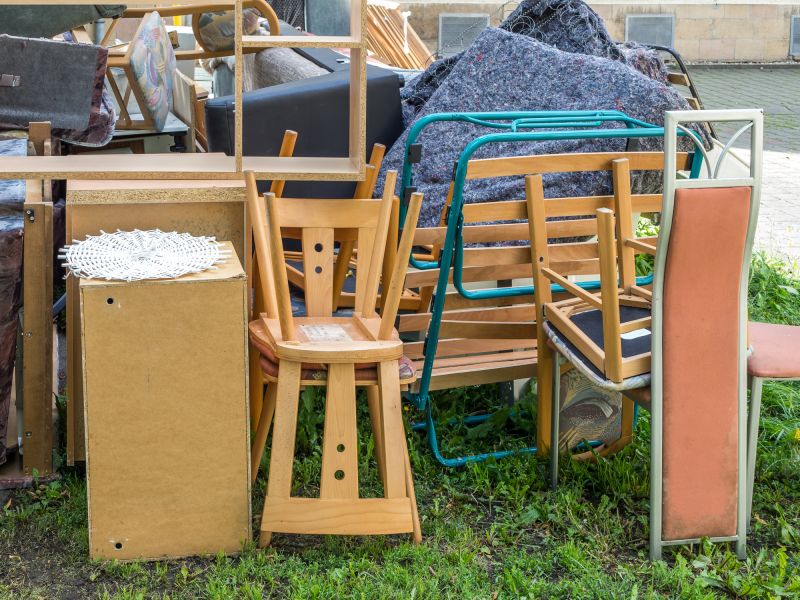Ultimate Guide to Old Furniture Disposals with Expert-Recommended Products
Find out which tools and accessories professionals trust for smooth and stress-free furniture removal.
 Disposing of old furniture can be a challenging task, especially when dealing with bulky or heavy pieces that are no longer serving their purpose. Fortunately, there are a variety of products designed to facilitate the removal and disposal process, making it more manageable and less labor-intensive. These solutions range from simple tools to comprehensive disposal systems, each suited to different types of furniture and disposal needs.
Disposing of old furniture can be a challenging task, especially when dealing with bulky or heavy pieces that are no longer serving their purpose. Fortunately, there are a variety of products designed to facilitate the removal and disposal process, making it more manageable and less labor-intensive. These solutions range from simple tools to comprehensive disposal systems, each suited to different types of furniture and disposal needs.
Top Overall Option
Multi-Purpose Furniture Dismantling Kit
A versatile dismantling kit equipped with various tools such as screwdrivers, pry bars, and gloves, designed to assist in breaking down old furniture safely and efficiently. Its comprehensive set allows for handling different furniture types and materials, making it a practical choice for DIY disposal projects.
Types of Products For Old Furniture Disposals
Furniture Removal Dolly
A sturdy dolly designed to help move heavy furniture with ease, reducing strain and risk of injury.
Furniture Sliders
Sliding pads that allow furniture to be moved smoothly across floors without damage.
Heavy-Duty Lifting Straps
Straps that assist in lifting and carrying large pieces safely, distributing weight evenly.
Power Saws
Electric saws suitable for cutting furniture into manageable pieces for disposal.
Crowbars and Pry Bars
Tools used to disassemble furniture by removing nails, staples, and joints.
Electric Sanders
Tools for stripping paint or veneer, facilitating dismantling and disposal.
Protective Gear Sets
Safety equipment including gloves, goggles, and masks to ensure safety during dismantling.
Furniture Disassembly Kits
Complete kits with screwdrivers, wrenches, and other tools tailored for taking apart furniture.
Transport Straps
Secure straps to stabilize furniture during transport to disposal sites.
Trash Bags and Containers
Heavy-duty bags and containers for collecting small debris and dismantled parts.
Furniture Removal Trucks
Small utility carts or trucks designed for transporting dismantled furniture safely.
Furniture Grippers
Devices that help grip and lift furniture securely.
Manual Hand Trucks
Compact hand trucks for maneuvering furniture in tight spaces.
Debris Chutes
Flexible chutes to safely direct debris from upper floors to disposal areas.
Furniture Stripping Tools
Specialized tools for removing upholstery, veneer, and other coverings.
Disposal Service Vouchers
Prepaid vouchers for professional disposal or recycling services.
Recycling Containers
Designated bins for separating recyclable furniture components.
Popular Choices
Widely used for moving large furniture pieces with minimal effort.
Popular for safely lifting and carrying heavy items.
Commonly utilized tools for disassembly and removal tasks.
Frequently chosen for protecting floors while moving furniture.
Convenient for quick disassembly of furniture parts.
Essential for protecting hands during dismantling and moving.
Popular for collecting debris and small dismantled parts.
Useful for moving multiple items efficiently.
All-in-one sets favored for their convenience and versatility.
Commonly used to protect eyes during cutting or sanding.
Frequently rented or used for large-scale disposal projects.
Popular for cutting through various materials quickly.
Often used to secure and lift furniture safely.
Widely used to separate recyclable furniture components.
Commonly employed for moving smaller furniture pieces.
When selecting products for old furniture disposal, it's important to consider factors such as the size and weight of the furniture, the type of material, and the disposal environment. Some products are designed for DIY dismantling, allowing you to break down furniture into smaller, more manageable parts. Others are geared toward professional disposal services, offering efficient ways to transport large items. Additionally, accessories like protective gear and moving straps can enhance safety and ease during the disposal process.
Proper disposal not only helps maintain a clean and organized space but also ensures safety during the removal process. Whether you're clearing out a single piece or an entire room's worth of furniture, choosing the right products can significantly streamline the task. It's advisable to evaluate your specific needs, available space, and disposal regulations before making a selection. With the right tools and products, old furniture disposal can become a straightforward, hassle-free task.
Investing in quality disposal products can also prevent potential injuries and damage to your property. From heavy-duty dollies to furniture sliders, there are numerous options to assist in moving and dismantling furniture safely. Remember to always follow manufacturer instructions and safety guidelines to ensure a smooth and secure disposal process.
Key Buying Considerations
- Assess the size and weight of the furniture to determine the appropriate tools and equipment.
- Consider the material composition of the furniture for suitable cutting or dismantling methods.
- Evaluate the disposal environment, such as indoor or outdoor settings, to select compatible products.
- Safety features are essential; look for tools with protective guards and ergonomic designs.
- Ease of use and assembly can impact the efficiency of the disposal process.
- Durability and quality of tools ensure they can withstand heavy use without failure.
- Compatibility of accessories, such as straps and dollies, with the furniture size is important.
- Check for compatibility with existing equipment you may already own.
- Consider the frequency of use—invest in higher-quality tools if disposal tasks are ongoing.
- Availability of replacement parts or accessories can extend the lifespan of your tools.
- Ease of transportation and storage should be factored into your choice.
- Budget constraints may influence the selection of professional versus DIY tools.
- Availability of local disposal or recycling services can influence the type of disposal products needed.
- Look for products with good safety reviews and user feedback.
- Opt for versatile tools that can handle different types of furniture and materials.
